Potato
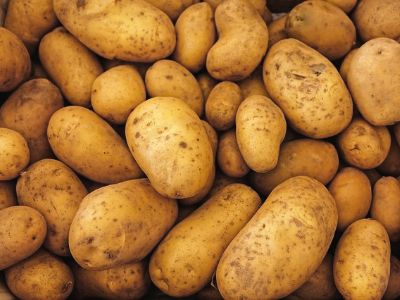
Preparation: Step-by-Step
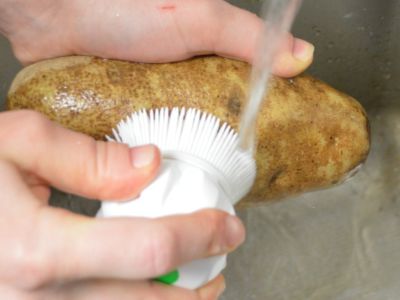
Wash hands. Thoroughly rinse potatoes to remove dirt. Re-rinse and scrub potato, if needed. Pat dry.
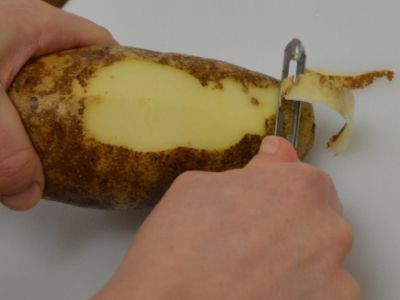
Peel skin off with knife or vegetable peeler, if desired. Remove blemishes with a paring knife. Cut potato in half. Place cut side down and slice to desired thickness.
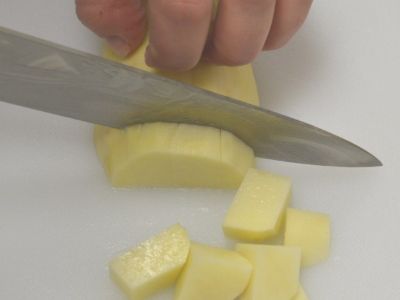
Cut slices again to dice to desired size or to recipe instructions.
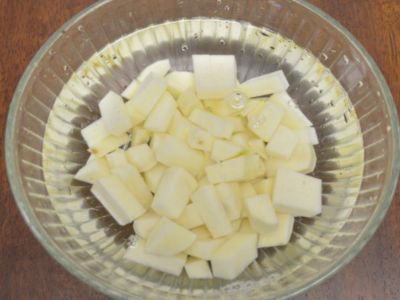
Store peeled or cut potatoes in cold water. Cover completely to prevent browning.
Grow.
- Plant only Montana Certified Seed Potatoes two weeks before last frost and when soil
temperatures are above 40°F. Avoid areas where you have planted tomatoes, peppers,
or eggplant in previous years. Cut seed potatoes into pieces about one inch across
with each piece having at least two “eyes.” Dig a deep (up to 12 inches) trench four
inches wide. Place seed with eyes up, 8-12 inches apart and cover with soil. Space
trenches two feet apart. Use row covers to protect from early season insects such
as flea beetles. Water heavily the first eight weeks with 1-2 inches of water per
week or more.
For more growing information, look for the MSU Extension MontGuide: Planting a Successful Home Vegetable Garden, or contact your local MSU Extension office.
Harvest.
- Potato harvest occurs when tops have died down and ground is dry. Be careful not to bruise when digging or storing.
- Whatever the variety, look for potatoes which are firm, and fairly clean. Avoid those with wrinkled or wilted skins, soft dark areas, discoloration, cut or bruised surfaces, or greening. Choose the variety with the end use in mind, see chart on second page for ideas.
- Best when stored in a dark, cool area, 42 to 48°F, with good ventilation. Do not refrigerate or freeze. Avoid placing potatoes in direct light. Temperatures warmer than 45°F encourage sprouting and shriveling; colder than 42°F encourages transformation of starch to sugar, which changes the taste and cooking properties.
- Most vegetables are rich in fiber and phytochemicals, but provide negligible amounts of saturated fat, trans fat, cholesterol, and sodium and are gluten-free. Potatoes are a good source of potassium, Vitamin C, Vitamin B6 and magnesium with 54 calories per half-cup serving.
Bake.
- Rinse and scrub potatoes. Allow to dry slightly. To prevent a crispy skin, rub with olive oil or butter. Pierce potato with a fork prior to baking to allow steam to escape. Place in 400°F oven and bake 45 minutes or until tender.
Boil or Steam.
- Rinse, peel (if desired), and cut potatoes in 1- to 2-inch cubes into steamer or pan of boiling water. Steam or boil about 20-30 minutes for cubed potatoes and 30-40 minutes for whole potatoes. To mash, use a hand held mixer or masher until desired consistency. Add seasonings to enhance flavor.
Microwave.
- Pierce a medium-size potato with a fork before placing on a paper towel in the microwave. Cook on high for 4-6 minutes, until tender.
Roast.
- Chop potatoes into 1/2-inch sections or long strips, place in plastic bag and shake with olive oil to coat. Spread on baking sheet and roast at 450°F for 30-40 minutes, turning frequently.
Season.
- To enhance the flavor of potatoes, use basil, bay leaf, celery seed, chives, curry powder, dill weed, garlic, ginger, marjoram, nutmeg, oregano, rosemary, tarragon and/or thyme.
Preserve.
-
- For more information on preserving vegetables, view these MSU Extension MontGuides: Freezing Vegetables, Drying Vegetables, and Home Canning Using Boiling Water and Pressure Canners. Or contact your local MSU Extension office.
For More Information:
Montana State University Extension: msuextension.org
MSU Extension Master Gardener: mtmastergardener.org
MSU Extension Food and Nutrition: nutrition.msuextension.org
MSU Extension Nutrition Education Programs: buyeatlivebetter.org
Date of Publication: January 2014
